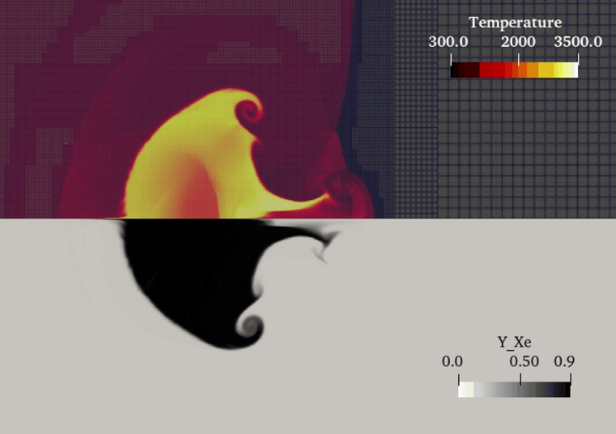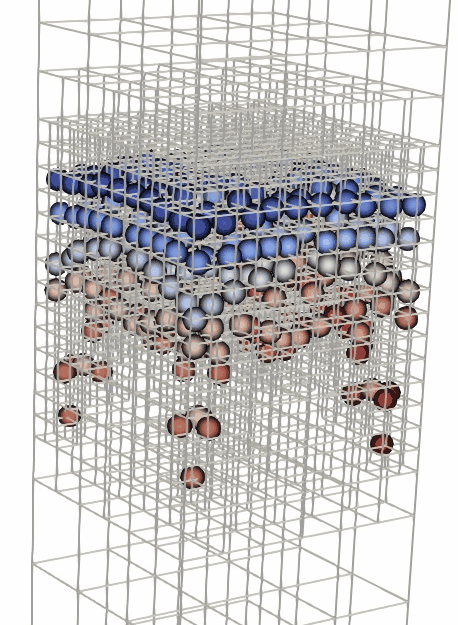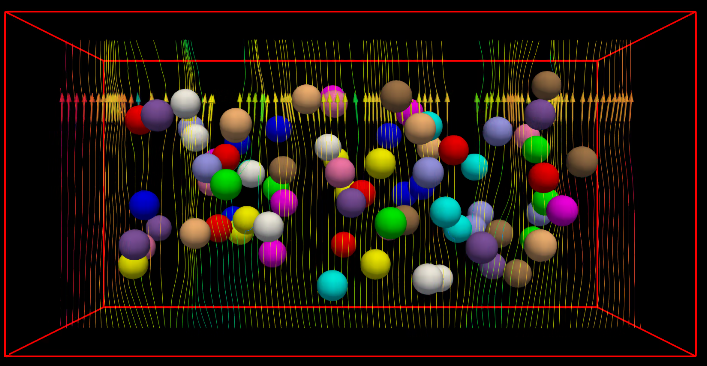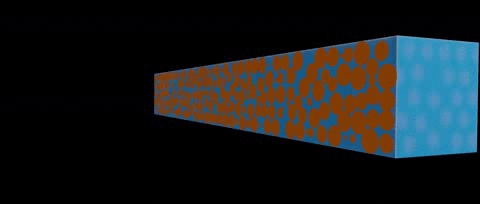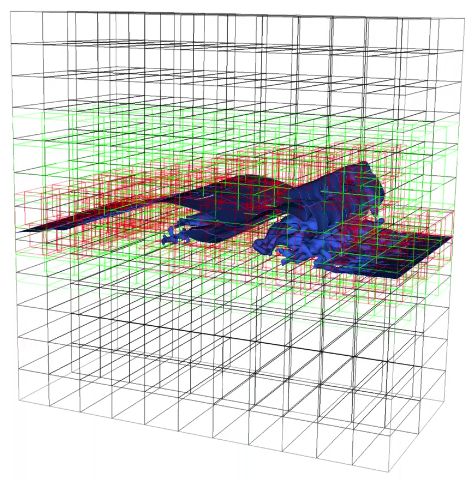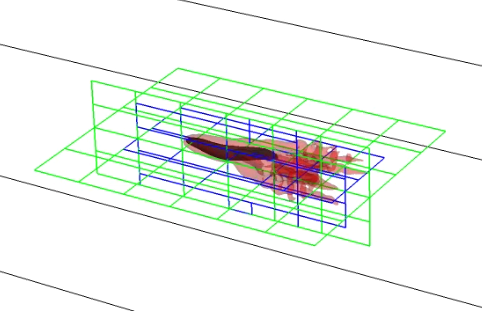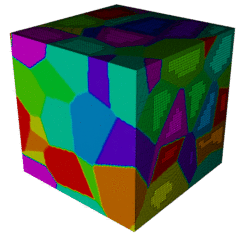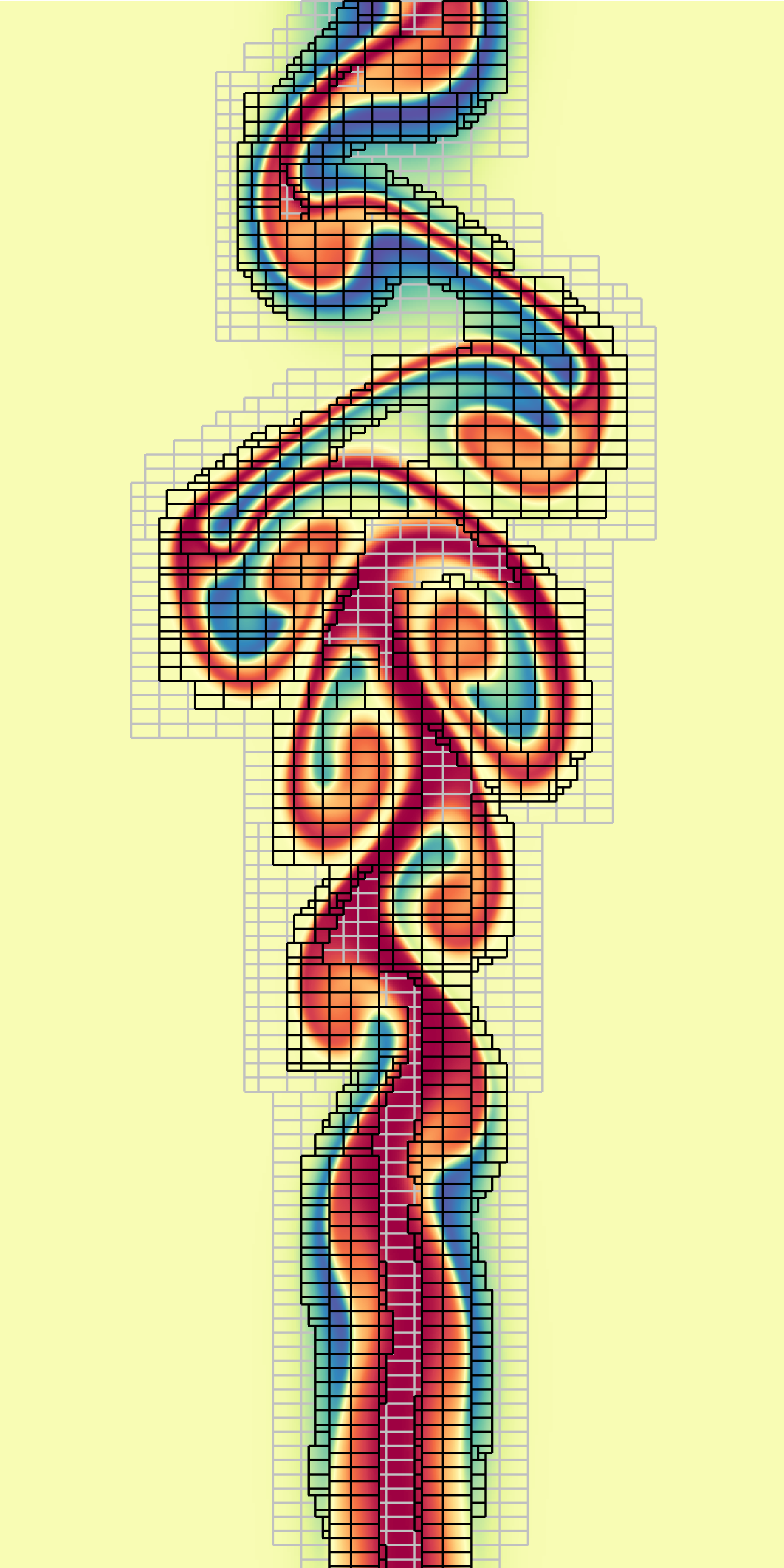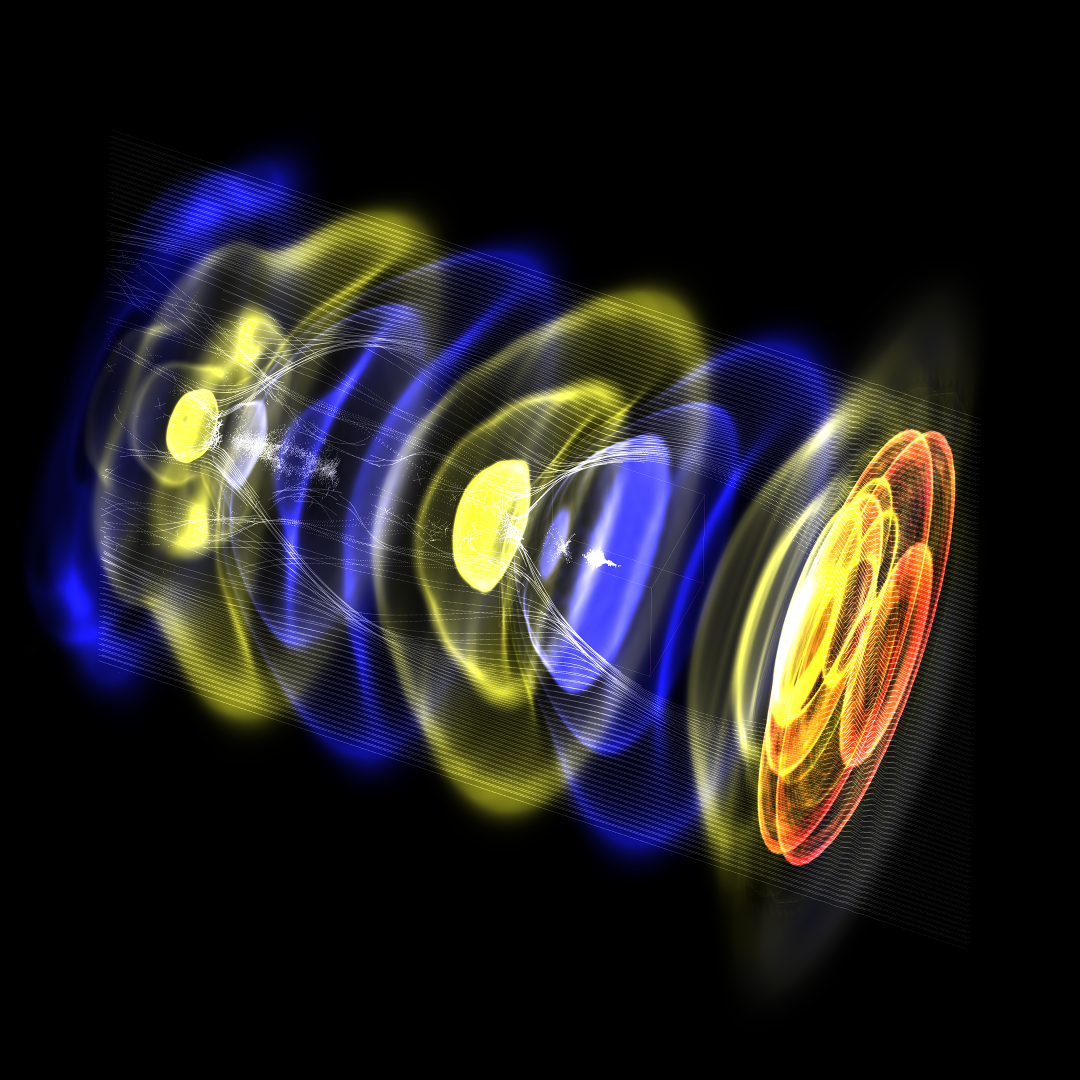If you would like to contribute to our gallery, please contact us.
Hybrid Simulation of Fungal Mycelium Growth
Image courtesy of Bruce Palmer, Connah Johnson, and William Cannon (PNNL).
Reactive Shock-Bubble Interaction
Image courtesy of Yuqi Wang, Yadong Zeng, and Jianhan Liang
Spherical Particles Settling
Image courtesy of Yaning Wang, Yadong Zeng, and Zhaohui Liu.
Quokka Star Cluster
Gravitational collapse and star formation in a giant molecular cloud simulated using Quokka.
Video courtesy of Ben Wibking and the Quokka development team.
Star formation and supernova feedback in a Milky Way-mass disk galaxy simulated using Quokka with 7 AMR levels.Quokka Galaxy
Video courtesy of Ben Wibking and the Quokka development team.
IAMReX: Parallel solver for particle-resolved simulations on multi-level gridsCluster of Monodisperse Particles
Image courtesy of Xuzhu Li and Zhengping Zhu.
Three-dimensional thunderstorm simulationThunderstorm in ERF
Video and Image courtesy: Mahesh Natarajan, Aaron Lattanzi and Ann Almgren, LBNL; Eliot Quon, NREL.
Flow Boiling as an Efficient Cooling Mechanism
Flash-X + AMReX enhanced multiphase solver
The simulation here shows the bubble dynamics and was performed using Flash-X ( https://www.sciencedirect.com/science/article/pii/S2352711022001030) + AMReX. Integration with AMReX has significantly improved the performance of incompressible multiphase problems within Flash-X compared to its predecessor FLASH ( https://www.sciencedirect.com/science/article/pii/S030193221930165X). In our recent article we talk about the performance improvements in the Poisson solver that has made this possible ( https://arxiv.org/abs/2306.10174).
Image courtesy of Akash Vijaykumar Dhruv (ANL).
A quasi-static particle-in-cell method for plasma wakefield accelerationHose instability in a plasma accelerator
This simulation was performed on GPU by the AMReX-powered code HiPACE++, providing orders of magnitude speedup compared to CPU counterpart [S. Diederichs et al. “HiPACE++: a portable, 3D quasi-static particle-in-cell code.” Computer Physics Communications 278: 108421 (2022)].
Image courtesy of Maxence Thévenet and Ángel Ferran Pousa, DESY (Hamburg, Germany), using the VisualPIC rendering tool.
A moving embedded boundary approach for the compressible Navier-Stokes equationsMoving bodies in compressible flow
"A moving embedded boundary approach for the compressible Navier-Stokes equations in a block-structured adaptive refinement framework", Mahesh Natarajan, Ray Grout, Weiqun Zhang, and Marc Day, Journal of Computational Physics, 11315, 2022.
Image Courtesy: Mahesh Natarajan, Ray Grout, Weiqun Zhang, and Marc Day
Solid composite propellant deflagration
Simulation of AP/HTPB burn in Alamo
A diffuse interface method for solid-phase modeling of regression behavior in solid composite propellants, B Kanagarajan, JM Quinlan, B Runnels, Combustion and Flame, 2022
Phase field modeling of solid phase AP/HTPB to determine the effect of particle distribution on regression rate, B Kanagarjan, JM Quinlan, B Runnels, AIAA SciTech, San Diego, CA, January 2022
Image courtesy of Brandon Runnels, Solid Mechanics Research Group, University of Colorado, Colorado Springs, CO.
Incompressible multiphase flow with high density ratio and high Reynolds number Stokes Breaking Wave
Zeng, Yadong, et al. "A parallel cell-centered adaptive level set framework for efficient simulation of two-phase flows with subcycling and non-subcycling." Journal of Computational Physics 448 (2022): 110740.
Image courtesy of Yadong Zeng and Lian Shen, Fluid Mechanics Lab, University of Minnesota.
Self-propelled swimming eel
A DLM immersed boundary method framework for solving fluid-structure interaction problems
Yadong Zeng, Amneet Pal Singh Bhalla, and Lian Shen. "A subcycling/non- subcycling time advancement scheme-based DLM immersed boundary method framework for solving single and multiphase fluid–structure interaction problems on dynamically adaptive grids." Computers and Fluids 238 (2022): 105358.
Image courtesy of Yadong Zeng and Lian Shen, Fluid Mechanics Lab, University of Minnesota.
All-Mach, Compressible Multiphase FlowAtomization of a Liquid Jet
A Robust All-Mach Multiphase Flow Algorithm for High-Fidelity Simulations of Compressible Atomization, M.B. Kuhn and O. Desjardins, ILASS-Americas 30th Annual Conference on Liquid Atomization and Spray Systems, Tempe, AZ, May 2019.
An all-Mach multiphase flow solver using block-structured AMR, M. Natarajan, R. Chiodi, M. Kuhn and O. Desjardins, ILASS-Americas 30th Annual Conference on Liquid Atomization and Spray Systems, Tempe, AZ, May 2019.
Image courtesy M. Natarajan, R. Chiodi, M. B. Kuhn, O. Desjardins, Computational Thermo-Fluids Laboratory, Cornell University.
Microstructure Evolution Using Solid Mechanics
Simulation of microstructure evolution in a polycrystalline solid using Alamo
Image courtesy of Brandon Runnels, Solid Mechanics Research Group, University of Colorado, Colorado Springs, CO.
Modeling Compressible Reactive Gas DynamicsDetonation Propagation and Failure
Image courtesy Brayden Roque, Hsiao-Chi Li, and Ryan Houim
Three-dimensional Hydrogen Jet
Detailed adaptive simulation of a burning Hydrogen jet with RNS
- A Fourth-Order Adaptive Mesh Refinement Algorithm for the Multicomponent, Reacting Compressible Navier-Stokes Equations , M. Emmett, E. Motheau, W. Zhang, M. Minion and J. B. Bell, submitted for publication, 2018.[arxiv]
Capturing transient behaviour of strain-rate-dependent rheological modelsYield-stress fluids
- Time-dependent viscoplastic fluid flow simulations in two and three dimensions, K. Sverdrup, N. Nikiforakis and A. Almgren, in preparation, 2018, arXiv:1803.00417
Detailed adaptive simulation of a burning Dimethyl Ether jet with RNSDimethyl Ether Jet
- A Fourth-Order Adaptive Mesh Refinement Algorithm for the Multicomponent, Reacting Compressible Navier-Stokes Equations , M. Emmett, E. Motheau, W. Zhang, M. Minion and J. B. Bell, submitted for publication, 2018.[arxiv]
Modeling the interaction between plasma and electronsLaser Wakefield Acceleration
Image courtesy Maxence Thévenet & the WarpX team.
Compressible Gas Dynamics with AMR Embedded BoundariesShock Reflection
Code Generation and Simulation of the Spacetime Evolution of Black Hole MergersBlack hole Collisions
The STvAR package was inspired by Professor Zach Etienne and the NRPy+ project at West Virginia University.
Videos and Images courtesy of Adam Peterson and Don Wilcox.
Simulation of Large Systems of Black Holes with Heavily Designed Initial ConditionsBlack Hole Advertising
The video shows the simulation of a very large system of black holes, starting from heavily designed initial conditions using the STvAR package. The entire video is run in reverse.
Videos and Images courtesy of Adam Peterson and Don Wilcox.

